
Sedimentology, Sequence Stratigraphy and Reservoir Characterisation Field CourseThe “Sedimentology, Sequence Stratigraphy and Reservoir Characterisation Field Course” runs over approximately one week in south-east and central Queensland. It is modular, so particular outcrops can be included based on specific training requirements. The course can include a section on modern environments, or focus entirely on ancient systems. |
|
Modern EnvironmentsCourses can visit either Hervey Bay or Moreton Bay in south-east Queensland to examine modern sedimentary environments as a way of consolidating the learning objectives of the course. The focus of the exercises in these locations is on providing analogues to the depositional settings which will be discussed throughout the course, with a particular emphasis on understanding the scale of each particular feature. |
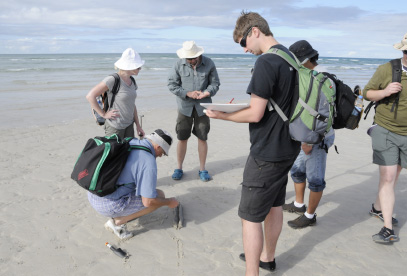
Students undertaking an exercise on a modern delta. |
Bowen/Surat Basin, Central QLDThis component of the field course is run through the Permian, Triassic and Jurassic stratigraphy of the Bowen and Surat Basins. This area provides (in places) excellent outcrop in easily accessible locations and has been the focus of extensive investigation for coal and petroleum resources. The course itinerary broadly follows the depositional history of the basis, beginning in the Permian and working up to the Jurassic. While this flyer shows the major outcrops, we will make informal stops at other outcrops of interest and point out other features during transit. |
|
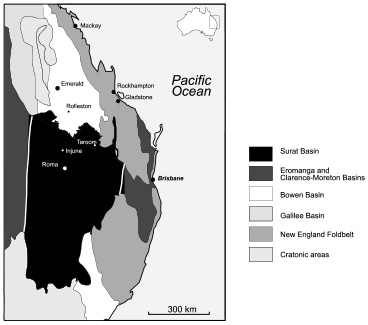
Geological framework of Central Queensland |
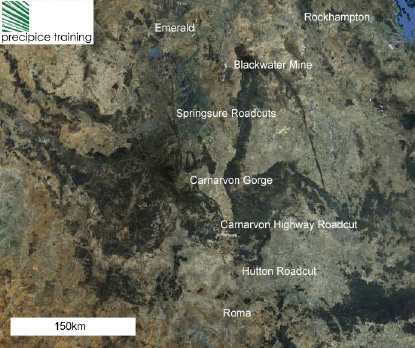
Outcrop locations in Central Queensland |
| | |
Core Shed Day in BrisbaneStudents will review core from the Freitag Formation, Staircase Sandstone, Precipice Sandstone, Clematis Group, Moolayember Formation, Evergreen Formation and Hutton Sandstone in the Exploration Data Centre in Zillmere. The aim of this day is twofold: 1) consolidate skills in making sedimentological observations, 2) to provide a comparison between the amount of detail that can observed from core and outcrop of the same units. |

Students undertaking core logging exercise |
| | |
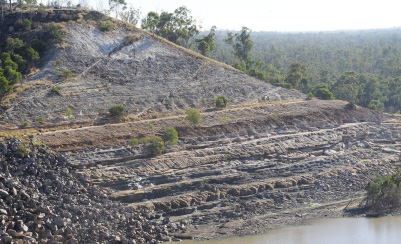
Frietag Formation, Fairbairn Dam, Emerald |
Freitag Formation, Emerald, Central QLD:This field day examines a superbly exposed and somewhat cryptic coastal succession of the Permian Freitag Formation which contains abundant well preserved sedimentary structures including trace fossils, excellent examples of various interlamination structures as well as HCS and load casting features. A major focus of this day is developing the skills of course participants in recognising these features and using them to inform their facies interpretations. Discussions at this outcrop (often led by frequent guest instructor Professor Stephen Hasiotis) emphasise the importance of integrating ichnological and sedimentological observations. |
| | |
Staircase Sandstone, Springsure, Central QLD:This field day examines Permian deltaic and shoreface facies, in an overall coarsening-upward succession within the Staircase Sandstone Member. These outcrops include storm, wave and tide influenced marine facies. The focus of this exercise will be on recognising the various components of deltaic sediments, examining reservoir geometry, and considering the sequence stratigraphic framework of these sections. |
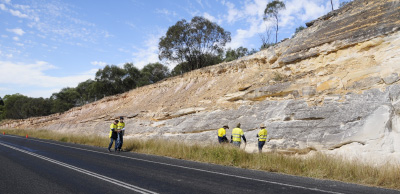
Students Logging a Section of the Staircase Sandstone |
| | |
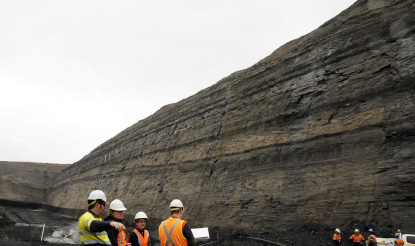
Students sketching the highwall of the Blackwater Coal Mine |
Rangal Coal Measures, Blackwater Coal Mine, Central QLD:Exercises at Blackwater Coal Mine are focused on the perfectly exposed Late Permian overbank and lacustrine facies present in the highwalls. Students will sketch highwalls to define the geometry of the facies present, and may compare these to core available from these units. |
| | |
Clematis Group/Moolayember Formation, Mickey Creek Gorge, Central QLD:Exercises in the Mickey Creek Gorge area are focused on low net to gross fluvial/lacustrine Triassic aged sediments. Students will log a large continuous section through this gorge, interpret the depositional environments present, discuss the expected lateral continuity of the units and be asked to place their observations within a sequence stratigraphic framework. |
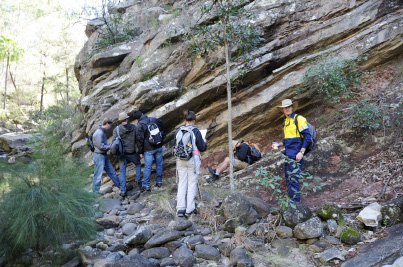
Students logging outcrop of the Clematis Group, Mickey Creek Gorge |
Precipice Sandstone, Carnarvon Gorge and Carnarvon Highway, Central QLDThe Jurassic Precipice Sandstone at Carnarvon Gorge is interpreted as a multi-storey, braided stream deposit while the road-cut of the same unit on the Carnarvon Highway is interpreted as mouthbar and delta front deposits of a braid delta. Outcrop of these units is excellent at both locations and elevated positions nearby provide opportunities for regional scale examination of these packages. Students are asked to make a stratigraphic log of each outcrop and present their observations to their peers. The learning objectives of working on these outcrops are to examine the facies stacking patterns of fluvial sandstones, understand the possibility of regional heterogeneity and to become aware of the possible lateral connectivity of similar units elsewhere. |
|
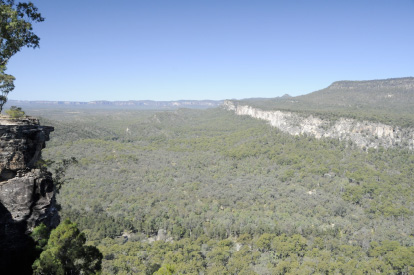
Regional perspective of the Precipice Sandstone, Carnarvon Gorge |
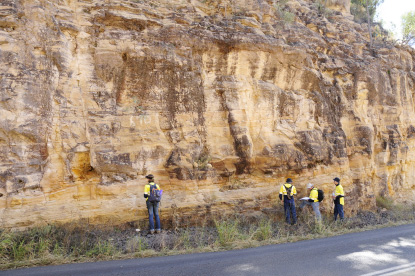
Logging the Precipice Sandstone, Carnarvon Highway |
| | |
Hutton Sandstone, Carnarvon Highway, Injune, Central QLDThe outcrop of the Jurassic Hutton Sandstone on the Carnarvon Highway contains evidence of an aggrading fluvial system comprising meandering pointbar successions that cut erosively into adjacent pointbar deposits. Students are asked to make a composite stratigraphic log and discuss the implications for lateral connectively of the facies present at this outcrop with their peers. The learning objective of this exercise is to provide a comparison to the fluvial systems observed at the Clematis and Precipice locations. |

Student exercise on the Hutton Sandstone, Carnarvon Highway |